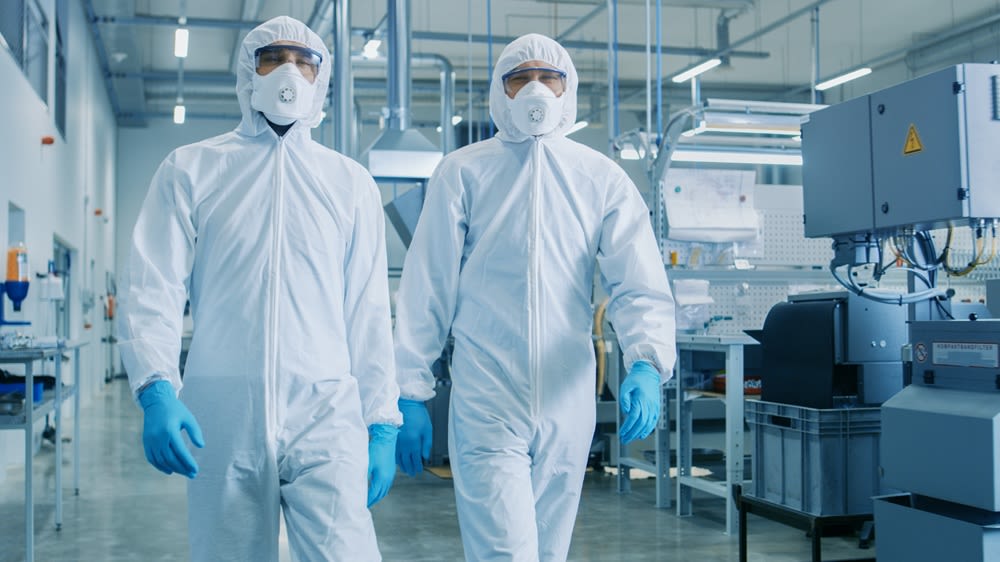
Clean room bunny suits protect sensitive equipment (like a microchip) from contaminants like lint and body hair. These suits are required in several different types of environments, including cleanrooms. Applying them properly and following a few best practices while you’re in the suit could help you avoid cross-contamination problems.
What Is a Clean Room Bunny Suit?
A clean room bunny suit (also known as a cleanroom suit, a bunny suit, or a sterile gown) covers the wearer from head to toe, trapping particulates and contaminants inside.
People who work in cleanrooms are often required to wear bunny suits. The cleanroom technology market was worth an estimated $7.2 billion in 2023, and people who run these rooms want to produce the best products they can. Clean room bunny suits make this possible.
In addition to requiring suits, cleanroom operators also outfit their facilities with pneumatic air filters and system hoods that direct air straight down. These tools keep contaminants away from sensitive products.
As the National Aeronautics and Space Administration (NASA) explains, people naturally shed things like hairs and skin cells throughout the day. Street clothes can also shed fibers when they’re rubbed or moved. While air filters can help keep these items from products, clean room bunny suits work better.
In 1999, experts said they felt bunny suits would be obsolete in a few years, as machines would assemble more machines without shedding particles. That hasn’t happened yet. Every day, thousands of people wear these suits while on the job.
10 Clean Room Bunny Suit Best Practices
By following a few simple steps, you can ensure that your clean room bunny suit is as effective as it can possibly be. Here’s what to do:
1. Use the Restroom First & Wash Your Hands
It takes time to get into (and out of) a clean room bunny suit. Ensure that you’ve visited the bathroom before you get started, and wash your hands carefully when you’re done.
2. Dress Light
In some companies, you’re required to change out of street clothes and into surgical scrubs before you put on a bunny suit. If you’re not required to change clothes, wear something similar to scrubs. Your bottom layer should be breathable (so you don’t get too hot) and not too fuzzy or fancy (so you don’t shed too many fibers).
3. Choose Closed-Toes Shoes
Most cleanroom operators require staff to wear solid, closed-toed shoes. If you drop equipment or something sharp, your shoes will offer more protection. The best shoes will have a smooth top (like a clog), so you can slide booties on and off quickly without them snagging on laces.
4. Cover Your Extremities
A bunny suit should cover all of your body, and it’s made of several components. Start the dressing process with your extremities. That means putting on a mask, hairnet, and shoe covers. If it’s possible, cover your hands with several pairs of gloves. If the outer level is dirty, you’ll have another pair below that’s ready to go.
5. Get the Right Fit
The body of your bunny suit should fit over your clothing and allow you to move comfortably. However, it should be snug enough that it won’t get caught on equipment and tear. If you’re not sure what size is right for you, ask your manager to help. If it doesn’t fit right, a clean room bunny suit is just not functional.
6. Keep the Suit Inside Out
Never touch the outside of your suit with your bare hands. If you follow these steps, you already have gloves on when you put on the suit. Do even more by keeping the suit turned inside out when you put it on. The suit should come packaged in this manner. Don’t adjust it or shake it out while you’re getting suited up.
7. Apply Other Tools From the Top Down
Your clean room bunny suit isn’t complete without another hairnet, another pair of booties, and another pair of gloves. Start at the top of your body and work down. Secure the ties as you go and ensure that your entire body is covered.
8. Check Your Reflection
Resist the impulse to smooth down your suit with your hands to look for gaps in coverage. Instead, step in front of a full-length mirror and check your reflection. If you spot uncovered areas, fix the problem before you enter the cleanroom.
9. Minimize Your Movements
Once you enter the cleanroom, keep your movements small and deliberate. Your suit shouldn’t shed fibers or cells, but you can help by reducing friction when you can. Consider your movements before you make them.
10. Inspect After Use
Keep your suit on throughout your time in the cleanroom. When your shift is complete, enter the changing room to remove your suit. Some parts (like gloves and booties) aren’t reusable. But others, including the body of the suit, can be reused. Inspect your suit when you remove it, and tell your supervisor if you spot anything like a tear or a hole. If the suit is damaged, it’ll need to be replaced.
Keep Industrial Uniforms Clean
Alsco Uniforms offers a uniform laundry service that could be just right for your cleanroom. We’ll clean your uniforms regularly and inspect them for damage. We’ll bring them back to you ready to go, with no hassle required on your part. We make the process as easy as possible for you, so you can focus on other aspects of your business. Contact us today to get started.
References
Cleanroom Technology Market Soars with a 6.1% CAGR. (January 2024). Global Newswire.
U.S. Cleanroom Technology Market Overview. Industry Arc.
Cleanroom Gowning or How to Dress in the Cleanroom. (April 2021). National Aeronautics and Space Administration.
These Bunnies Just Keep Going. (April 1999). SF Gate.
Principle of Cleanroom. (August 2013). Fundamentals of Air Cleaning Technology and Its Applications in Clean Rooms.
Spaces: The Clean Room. (Summer 2023). Rice Magazine.
